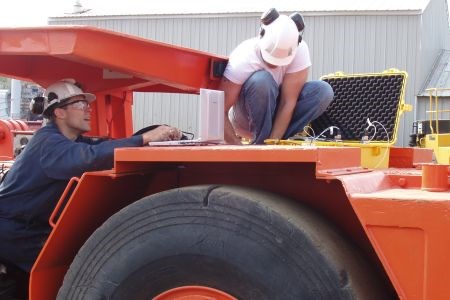A University of Windsor engineer is applying his automotive expertise to make one aspect of underground mining safer.
Bill Altenhof, a mechanical engineering professor, is collaborating with North Bay’s Workplace Safety North to investigate how wheel rim assembly in mining vehicles can fail.
Undetected cracks in the wheel rims caused by fatigue or improper handling can cause pieces to fly off that can seriously injure or kill anyone handling them.
Unlike single rims on automobiles, mining ore haul vehicles use rims with three to five pieces that lock together to support the heavy loads they carry.
The large 32-ply tires are sometimes five feet in diameter and contain 100 pounds of pressure per square inch.
Accidents don’t happen every often, but when they do, they have a devastating effect. When under severe pressure, the metal pieces of the wheel assembly such as the locking rings can fly off and travel several hundred feet.
“The volume of air and force can lift a small car. It’s like a bomb in an envelope,” said Rick Banting, an electrical and mechanical specialist, with North Bay’s Workplace Safety North (formerly known as MASHA).
“Most of the mines that I’m aware of are diligent and have been for a number of years on maintenance and training employees on how to deal with it. But there have been cases of serious injury in Canada.”
Exploding wheel rim assemblies killed two mechanics at the Detour Gold and Musselwhite mines in 2000.
It’s not just an Ontario mining problem, but a worldwide one.
Those issues led Banting to discover research by Altenhof, who had worked with Ford Motor Company in resolving a fatigue crack issue with high-performance aluminium and magnesium road wheels.
“We were able to characterize mechanical material behaviour at different parts of the rim and incorporate that into a computer model to improve the design,” said Altenhof. “It led to a better performing wheel that didn’t exhibit any cracking and saved a lot of money.”
He hopes to deliver the same results for the mining industry as part of his three-year study funded by the Workplace Safety and Insurance Board.
Altenhof has been developing computer models and doing experimental testing on two-piece mining vehicle rims, trying to identify the issues behind failure rates and how improvements can be made in the design of the rims.
Fatigue cracks act like a weak link on a chain. If it fails, it can lead to catastrophic failure. Each component of a multi-piece rim assembly has to be in the correct shape and be maintained.
Much of the problem goes back to the vehicle’s operation and making sure safety procedures are followed.
The cause of failure is often tire pressure.
The design of the multi-piece depends on the correct tire pressure to hold everything in place. Running on a flat tire jeopardizes the integrity of the assembly.
“If the pressure is not as designed, a tire can go flat and that can create problems,” said Banting.
To understand the root causes and develop a rationale of mining wheel failures, Altenhof brought his research team to Northern Ontario in May and June, visiting mines and suppliers like Xstrata’s Nickel Rim mine in Sudbury, and McDowell Equipment Sales and North Shore Industrial Wheel Manufacturing in Sault Ste. Marie.
“We’re not going to re-invent the wheel, but enhance it,” said Altenhof.
He was accompanied to Northern Ontario by a graduate student, Weldon Li, who won a three-year post-graduate doctoral scholarship worth $61,000 from the federal NSERC (Natural Sciences and Engineering Research Council) for the study.
They are focusing on underground haul trucks, like scoop trams (also known as load haul dumps), used to scoop out extracted ore with a bucket.
“Underground is probably the harshest environment with the machine loading, a corrosive environment (which causes rust) and striking the mine wall,” said Banting. But incidents of worldwide failures are not just limited to underground equipment.
Banting said the knowledge gained from this research can possibly have some cross-over use in the forestry industry for operators that use a similar type of rim on their vehicles.
“I really hope industry will get something out of this,” said Altenhof.
This project’s objectives include coming up with fail-safe mechanical systems for the wheel that vehicle operators and mechanical people must follow with set procedures.
As well, they want to factor material degradation into their computer models to better predict mechanical performance and possibly investigate replacing multi-piece rims with a single piece rim.
Some companies have given Altenhof rims to do non-destructive testing in their Windsor lab to simulate loading conditions. Around that, they devise a numeric and computer model to assess and locate the exact locations where fatigue cracks start to appear.
The Workplace Safety Insurance Board is funding Altenhof ’s research with a $225,000 grant while companies like Goodyear Canada, Vale, North Shore Wheel, J & M Tire and Workplace Safety North have responded with in-kind contributions.




